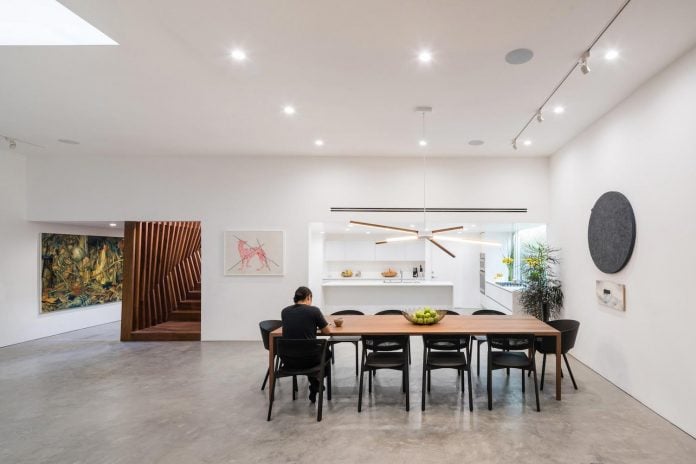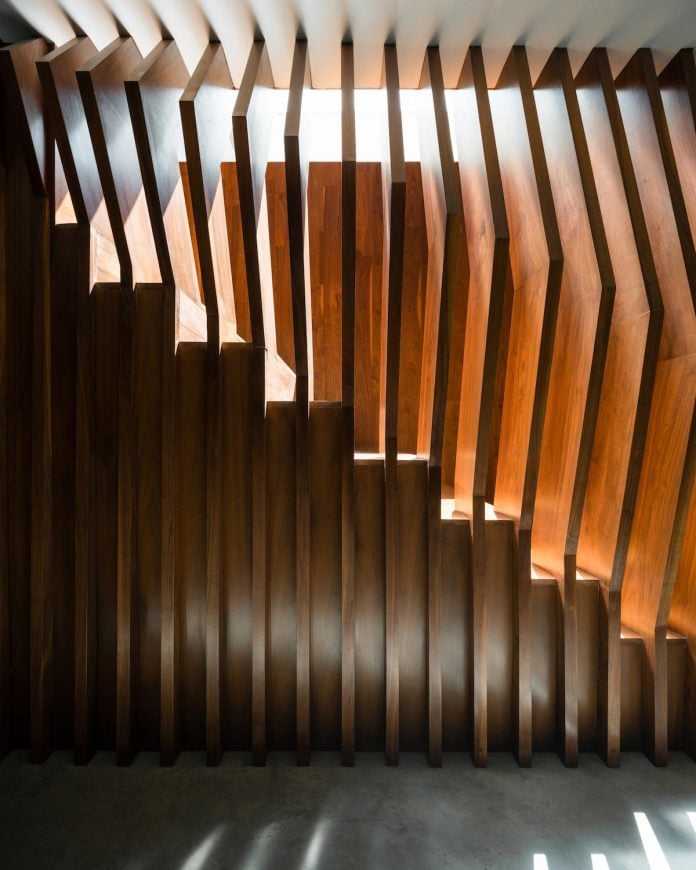Stunning home using minimalist aesthetic, while incorporating design cues from the home’s original architect by Dan Brunn Architecture
Architects: Dan Brunn Architecture
Location: Los Angeles, United States
Year: 2016
Area: 3.600 ft²/ 334 m²
Photo courtesy: Brandon Shigeta
Description:
“Los Angeles‐based architect Dan Brunn, AIA, Principal of Dan Brunn Architecture, redesigned the 3,600‐square‐foot former Janss Family residence—a hub associated with the contemporary L.A. art scene in the 1970s and 1980s—by using his minimalist aesthetic, while incorporating design cues from the home’s original architect Frank Gehry, FAIA. The entire first floor was gutted to create an open‐air plan that accommodates work and display space for the owner, artist James Jean, as well as domestic necessities.
Interiors are arranged around an existing oversized rectangular skylight. New windows were added to bring additional natural light into the kitchen and living areas. Brunn created a dynamic undulating staircase wall and utilized primary building materials—such as wood, concrete, and glass—as a nod to the architectural shapes and material palette famously used by Gehry at the time.
A fish‐scale copper‐clad entryway leads into a compressed vestibule that begins to introduce dominant themes of white vertical planes and the concrete ground plane, both disrupted by walnut surfaces. Before the expansive living area, the sculptural statement of the home emerges in the form of an expressive stairway. The first hint appears upon arrival, with the beginning of a walnut wall leading from the entry into the living room, but with a slight protrusion into the walkway. The shifting shapes and angles are in homage to Gehry as well as to Jean, who features flowing arabesques in his detailed work.
Handcrafted, the walnut staircase extenuates the verticality of the space, beckoning one up the stairs. The dynamic swoosh shape captures the light throughout the day, accentuating the golden tones of the wood, as the slats encourage a dance of light and shadow. Planes continue to shift as one moves around the stairs, creating varied experiences going up and down.
Brunn instilled a feeling of openness and continuum throughout the first‐floor home/work space. Interiors are meant to serve as a gallery‐like setting for the homeowner’s changing art displays. The rectangular skylight (the only architectural detail executed from Gehry’s original plan) remains as a fundamental design element. Brunn re‐thought it by outfitting it with stretch fabric to create an ambient glow, and installing LED lights that can emit glowing color. During the evening hours, the glowing ceiling plane transforms the mood of the space through the play of color.
Minimal furnishings define “rooms” within the open plan and provide comfortable seating, yet allow art to remain center stage. A charcoal‐colored area rug demarcates the conversation area bound by an Italian sofa with integral shelves in the arms and two black‐and‐tan leather sling chairs designed by Jean Prouvé in 1930. The reclaimed timber coffee table is custom made for the space with traditional Japanese joinery. It is a fitting counterpart to the fine and intricate lines found in a massive canvas by Jean that overlooks the living area.”









Thank you for reading this article!











